Volkswagen Australia has refreshed its Amarok range for the 2025 model year, led by the introduction of the limited-edition Amarok 10 Deserts Edition.
Priced from $69,990 drive-away, this new variant is limited to just 300 units nationwide and features a 40mm suspension lift, increasing ground clearance to 275mm. The off-road-ready vehicle rides on Continental ATR tyres fitted to 17-inch satin black wheels and includes VW underbody protection and all-weather floor mats. The exterior is distinguished by a black sports bar, soft tonneau cover, and black ‘10 Deserts’ decal that stretches across both the front and rear doors.
Alongside the launch of the 10 Deserts Edition, Volkswagen has announced several updates across the broader MY25 Amarok line-up. The Amarok Style, PanAmericana and Aventura variants now come standard with 230V power sockets (Australian plug pattern), backed by an integrated 400W inverter. Trailer Assist is now a standard feature on these models as well, and the Rear Traffic Alert system has been revised to integrate with the trailer support functionality.
VW has also introduced new ‘Tray’ cab-chassis variants. The Amarok Core, Life and Style are now available with a factory-fitted alloy tray, measuring 1900mm in external width, 1835mm in internal width, 1650mm in internal length, and tipping the scales at 132kg. This alloy tray will also be offered as a dealer-fitted accessory across the broader Amarok range and will cost an additional $4000. A steel tray weighing 243kg is also available as a dealer-fit option.
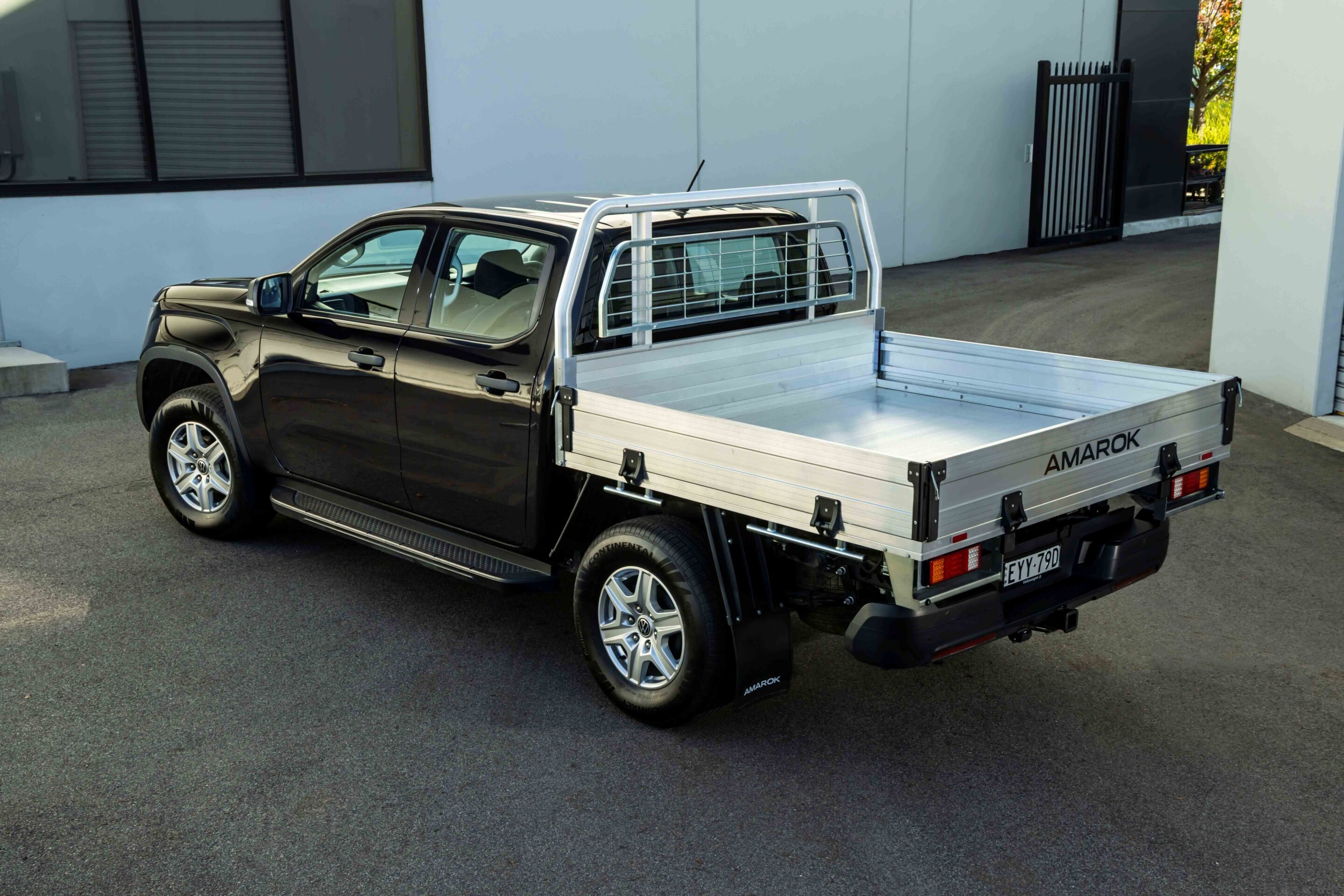
Drive-away pricing for the updated MY25 Amarok range starts at $55,990 for the Core TDI405. The Amarok Life TDI500 follows at $61,990, while the new 10 Deserts Edition, based on the TDI500 platform, lands at $69,990.
The Style variants are priced at $72,740 for the TDI500 and $76,740 for the TDI600. Sitting above them is the PanAmericana TDI600 at $79,990. At the top of the range, the Aventura is offered in two powertrains: the petrol-powered TSI452 at $79,990 and the flagship diesel TDI600 at $82,990.
The updated MY25 Volkswagen Amarok line-up will begin arriving in dealerships during the second half of 2025.
2025 VW Amarok RRP
| Model | Engine | RRP (AUD) |
|---|---|---|
| Amarok Core | TDI405 | $55,490 |
| Amarok Life | TDI500 | $59,490 |
| Amarok 10 Deserts Edition (new) | TDI500 | $68,490 |
| Amarok Style | TDI500 | $69,740 |
| Amarok Style | TDI600 | $73,740 |
| Amarok PanAmericana | TDI600 | $78,990 |
| Amarok Aventura | TSI452 | $79,990 |
| Amarok Aventura | TDI600 | $82,990 |
2025 VW Amarok manufacturer’s drive-away pricing
| Model | Engine | Drive-Away Price (AUD) |
|---|---|---|
| Amarok Core | TDI405 | $55,990 |
| Amarok Life | TDI500 | $61,990 |
| Amarok 10 Deserts Edition (new) | TDI500 | $69,990 |
| Amarok Style | TDI500 | $72,740 |
| Amarok Style | TDI600 | $76,740 |
| Amarok PanAmericana | TDI600 | $79,990 |
| Amarok Aventura | TSI452 | $79,990 |
| Amarok Aventura | TDI600 | $82,990 |
The 2026 Ford Ranger Super Duty is gearing up to challenge the long-held dominance of the Toyota LandCruiser 79 Series in Australia’s tough work and off-road ute segment.
While the LandCruiser has earned its reputation over decades as a rugged, go-anywhere machine, the Ranger Super Duty promises to rewrite the rulebook with serious payload, torque, and towing figures. This showdown breaks down how these two heavy hitters stack up, especially for those who need more than just a weekend cruiser – it’s about real work, big loads, and getting through harsh terrain without compromise.
JUMP AHEAD
Payload
Payload figures for the Ranger Super Duty are based on the Cab-Chassis variants, which offer the highest ratings in the lineup. The Single Cab leads with a payload capacity of up to 1,982 kg, followed by the Super Cab at 1,896 kg and the Double Cab at 1,825 kg. These numbers clearly target commercial operators and fleet users who require maximum legal carrying capacity.
In comparison, the LandCruiser 79 Series offers a payload range from 1,310 kg (Double Cab) to 1,380 kg (Single Cab). While still respectable and long trusted for remote operations, the Cruiser trails the Ford on the spec sheet in terms of payload performance.
| Model | Braked Towing Capacity | Gross Combined Mass (GCM) |
|---|---|---|
| Ranger Super Duty Cab-Chassis (2026) | 4,500kg | 8,000kg |
| LandCruiser 79 Series | 3,500kg | 7,010kg |
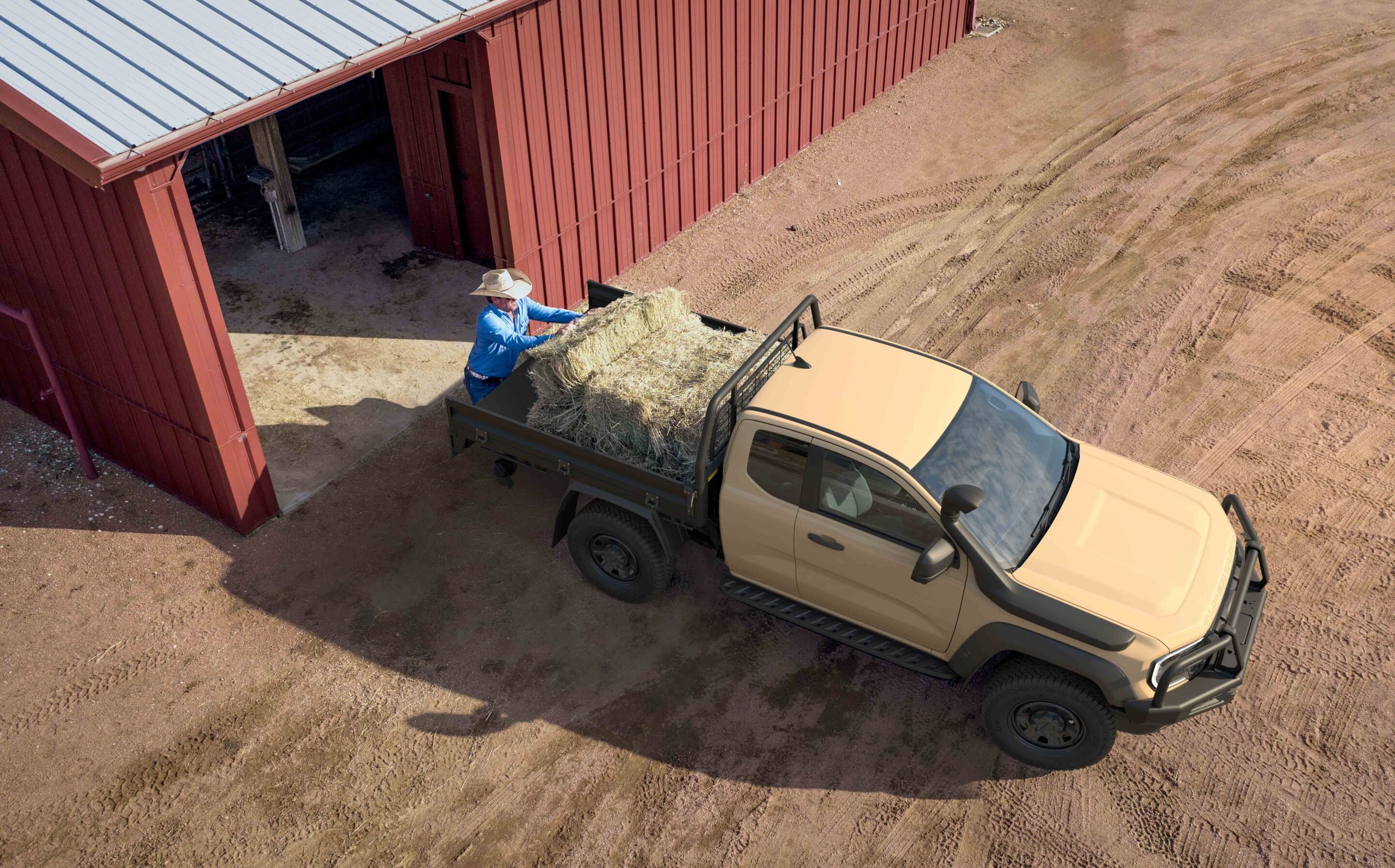
Towing and GCM
The Ranger Super Duty Cab-Chassis is engineered for serious pulling power, rated to tow up to 4,500 kg with a braked trailer. It also delivers an 8,000 kg Gross Combined Mass (GCM), allowing more flexibility for heavy loads, trailers, or fifth-wheel setups.
The 79 Series, while long regarded for its towing dependability, falls behind with a 3,500 kg braked towing capacity and a GCM of 7,010 kg. It’s still more than capable for most off-road and farm duties, but the numbers speak to the Ford’s modern engineering edge.
| Model | Braked Towing Capacity | Gross Combined Mass (GCM) |
|---|---|---|
| Ranger Super Duty Cab-Chassis (2026) | 4,500kg | 8,000kg |
| LandCruiser 79 Series | 3,500kg | 7,010kg |
Powertrain
Under the bonnet, the Ranger Super Duty features Ford’s 3.0-litre V6 turbo-diesel, producing 154 kW and a class-leading 600 Nm of torque. It’s a modern unit aimed at high-load, high-duty cycles typical of mining, fleet, and rural service vehicles.
The 79 Series offers buyers two engine choices. The newer 2.8-litre four-cylinder turbo-diesel, paired with a six-speed automatic, delivers 150 kW and 500 Nm. The long-serving 4.5-litre V8 turbo-diesel produces 151 kW and 430 Nm – less torque, but valued for its simplicity and off-road reliability.
| Model | Engine | Power Output | Torque |
|---|---|---|---|
| Ranger Super Duty (2026) | 3.0L V6 Turbo-Diesel | 154kW | 600Nm |
| LandCruiser 79 Series (2.8 I4) | 2.8L I4 Turbo-Diesel | 150kW | 500Nm (auto) |
| LandCruiser 79 Series (4.5 V8) | 4.5L V8 Turbo-Diesel | 151kW | 430Nm |
Off-Road dimensions
The Ranger Super Duty Cab-Chassis maintains solid off-road credentials, with ground clearance between 297 mm and 299 mm, and a best-in-class wading depth of 850 mm. While not marketed as a pure off-roader, the clearances and approach angles suggest it can handle remote and rugged worksites with confidence.
The LandCruiser 79 Series remains one of Australia’s most trusted off-roaders. Its clearance ranges from 302 mm to 330 mm depending on variant and tyres, and it manages a wading depth of 700 mm. For sheer outback dependability, it still has the edge on clearance.
| Model | Ground Clearance | Wading Depth |
|---|---|---|
| Ranger Super Duty Cab-Chassis (2026) | 297-299mm | 850mm |
| LandCruiser 79 Series | 302-330mm | 700mm |
Weight and load ratings
Weight capacity matters when towing or working off-road fully loaded. The Ranger Super Duty Cab-Chassis has a GVM of 4,500 kg – the legal limit before requiring a light rigid (LR) truck licence – and a GCM of 8,000 kg.
The 79 Series carries a GVM of 3,510 kg and GCM of 7,010 kg. These figures keep it firmly within standard car licence territory, though it gives up some capacity compared to the Ford.
| Model | Gross Vehicle Mass (GVM) | Gross Combined Mass (GCM) |
|---|---|---|
| Ranger Super Duty Cab-Chassis (2026) | 4,500kg | 8,000kg |
| LandCruiser 79 Series | 3,510kg | 7,010kg |
Pricing
The Ranger Super Duty Cab-Chassis lineup starts at $82,990 for the Single Cab, climbs to $86,490 for the Super Cab, and tops out at $89,990 for the Double Cab. These prices reflect its high payload and towing figures, and target heavy-duty operators and commercial buyers.
LandCruiser 79 Series pricing varies more depending on trim and engine. Single Cab models range from $76,800 for the 2.8 WorkMate to $85,000 for the 4.5 GXL. Double Cab variants range from $77,300 to $87,600. It remains a premium-priced product with reputation and longevity on its side.
| Model | Price |
|---|---|
| Ranger Super Duty Cab-Chassis (2026) | |
| – Single Cab | $82,990 |
| – Super Cab | $86,490 |
| – Double Cab | $89,990 |
| LandCruiser 79 Series – Single Cab | |
| – 2.8 WorkMate | $76,800 |
| – 2.8 GX | $78,800 |
| – 2.8 GXL | $80,900 |
| – 4.5 GXL V8 | $85,000 |
| LandCruiser 79 Series – Double Cab | |
| – 2.8 WorkMate | $77,300 |
| – 2.8 GXL | $81,500 |
| – 4.5 GXL V8 | $87,600 |
Final say
The upcoming Ranger Super Duty marks a significant step forward in the mid-size truck segment. More detailed information on the XLT trim and pick-up body styles will be revealed closer to the vehicle’s official release, promising added refinement and versatility for private and recreational buyers.
The GWM Tank 300 has been updated for 2025, with the Chinese marque increasing the towing and payload capacities of both its petrol and hybrid variants.
This towing capacity bump from 2500kg to 3000kg now brings the petrol and hybrid models in line with the Tank 300 diesel, which launched in Australia earlier this year. Payload capacities have increased by a minimum of 600kg across the range.
These improvements have been made possible by the implementation of more than 20 engineering enhancements, including larger front brakes and calipers; strengthened front knuckles; upgraded wheel bearings; and a reinforced prop shaft.
“These important updates reflect our global team’s growing understanding of the Australian market, where towing capability and payload remains a key consideration for buyers in this segment”, said Steve Maciver, GWM’s Head of Marketing & Communications.
GWM has also streamlined its local line-up, axing the Tank 300 Lux grade, in both petrol and hybrid configurations. GWM says they have been discontinued to “align with a shift of customer preference towards diesel”, with the Tank 300 diesel now accounting for 60 per cent of monthly sales.
The culling of these two models has cut the Tank 300’s Australian line-up to four variants: the Tank 300 Lux (diesel); and the Tank 300 Ultra (petrol, diesel and hybrid).
Despite these updates, GWM has left the pricing for its Tank 300 unchanged.
Specs: 2025 GWM Tank 300
| Specification | Tank 300 Lux Diesel | Tank 300 Ultra Petrol | Tank 300 Ultra Diesel | Tank 300 Ultra Hybrid |
|---|---|---|---|---|
| Driveaway price | $47,990 | $49,990 | $51,990 | $56,990 |
| Max Braked Towing Capacity – kg | 3,000 | 3,000 | 3,000 | 3,000 |
| Unbraked Towing Capacity – kg | 750 | 750 | 750 | 750 |
| Kerb weight – kg | 2,280 | 2,155 | 2,280 | 2,335 |
| Front & rear kerb weight – kg | 1,270 / 1,010 | 1,173 / 982 | 1,270 / 1,011 | 1,250 / 1,085 |
| Max front axle load – kg | 1,365 | 1,275 | 1,365 | 1,350 |
| Max rear axle load – kg | 1,515 | 1,490 | 1,515 | 1,585 |
| Gross vehicle mass (GWM) – kg | 2,880 | 2,765 | 2,880 | 2,935 |
| Payload – kg | 600 | 610 | 600 | 600 |
The Lexus LX has been refined for 2025, with the flagship SUV receiving a suite of updates including the introduction of the Overtrail variant.
Tailored for off-road performance, the five-seat Overtrail comes equipped with front and rear locking differentials; unique 18-inch matte grey alloy wheels wrapped in high-profile Toyo Open Country all-terrain tyres; and distinctive design elements including black treatment to the radiator grille, front and rear bumpers, door handles, wheelarches, outer mirrors and door window mouldings.
In addition to the trio of locking diffs, the LX Overtrail is equipped with a suite of off-road traction aids including Multi-Terrain Select, Downhill Assist Control, Crawl Control, a Multi-Terrain Monitor and Active Height Control.
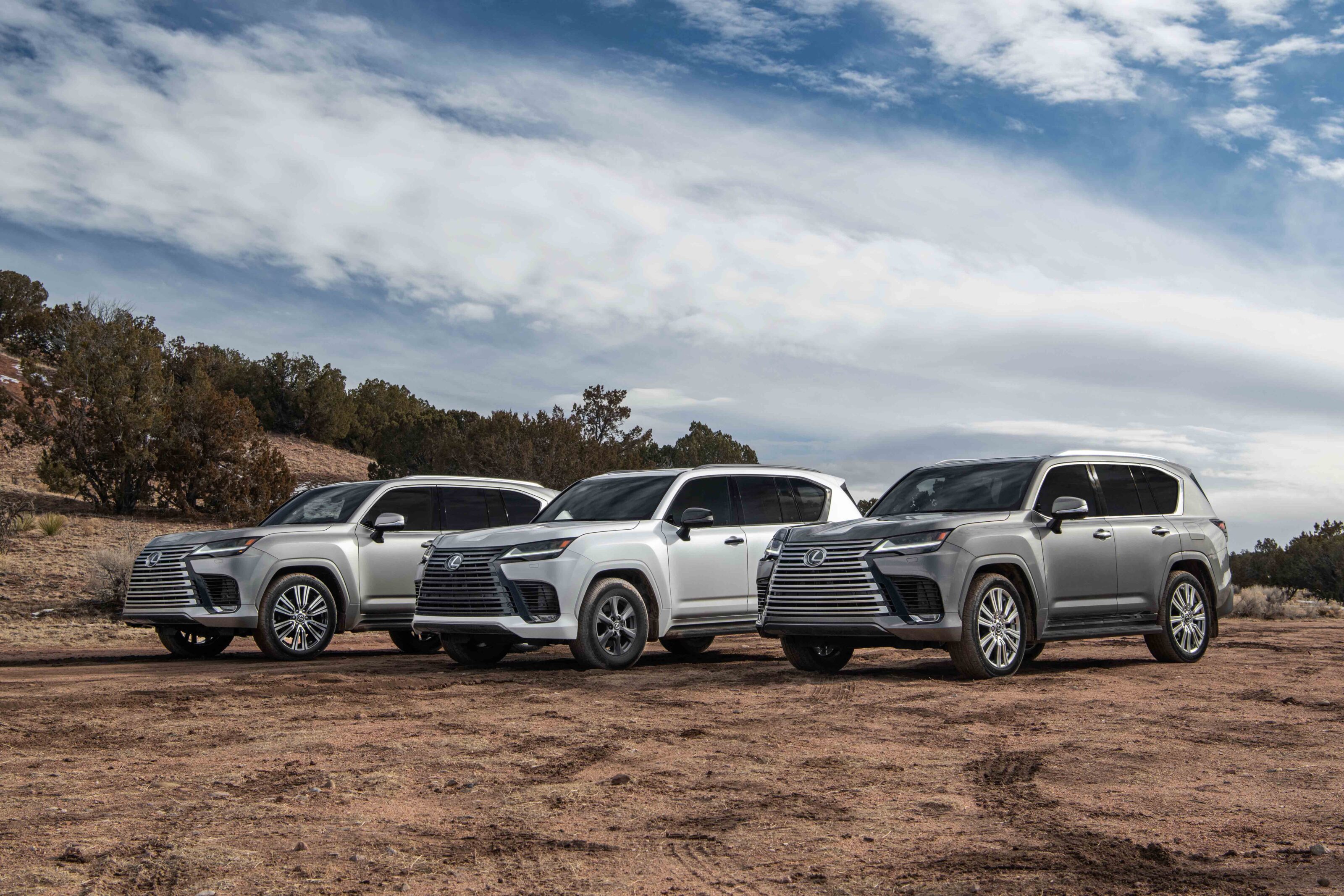
Like the rest of the LX range, the Overtrail does not come cheap, priced at $182,300 for the diesel and $185,800 if petrol power is desired. The cheapest entry point into the range is with the LX Luxury seven-seater, which starts at $158,700 (diesel) or $162,200 (petrol). The line-up tops out with the LX Ultra Luxury at a whopping $220,950 (petrol only).
Prices have increased by between $2724 and $3324 across the range, excluding the newly introduced Overtrail, which was confirmed by Lexus earlier this year.
The Lexus LX remains powered by two twin-turbocharged V6 engines: a 227kW/700Nm 3.3-litre 500d diesel and a 305kW/650Nm 3.5-litre 600 petrol. Both are paired to a 10-speed auto and a full-time 4WD system. Both powertrains carry a 3500kg braked towing capacity.
Across the range, the outgoing eight-inch multi-information display has been replaced with a fully digital 12.3-inch unit. Wireless Android Auto now joins Apple CarPlay as a standard feature, as does the inclusion of a centre console cool box and an additional USB-C port, giving the burly SUV six in total.
As part of the update, the mid-tier Sport Luxury and LX F Sport grades now get driver and front passenger massaging seats and four-way adjustable headrests. The top-spec Ultra Luxury also gains a front wireless smartphone charger as standard.
Safety updates to the LX range include the expansion of the Lexus Safety System+ suite, which adds motorcyclist detection (day) and cyclist detection (day and night); autonomous emergency braking when crossing intersections; acceleration suppression at low speeds; safe exit assist; an emergency driving stop system; and a driver monitor camera.
The updated Lexus LX range is out now.
Walkinshaw’s collaboration with Volkswagen will continue, with confirmation that the second-gen, Walkinshaw-tuned Amarok has been given the green light.
Reports indicate that the vehicle is slated to launch in Australia in 2026, with testing to begin within the next few months. It is expected that the Walkinshaw Amarok will retain the stock Amarok’s powertrain, in either 184kW/600Nm V6 or 222kW/452Nm four-cylinder turbo-petrol guise – as seen in the top-spec Aventura.
Details are scarce at this stage, with only a shadowy render released at this stage (above). However, the teaser image does reveal a unique grille pattern, an LED light bar running between (and connecting) the headlights, a sailplane, wider wheel arches, and alloy wheels.
The upcoming variant will build on the success of the W580 – the last iteration of which was the W580X, an off-road-focused variant given a suspension lift and off-road tune courtesy of MTV twin-tube dampers front and rear. It was also strengthened with underbody protection and heavy duty rock sliders. The W580S was a road-oriented version wearing 20-inch alloys, and road-biased suspension.
The Walkinshaw-fettled W580 utilised a tuned 3.0-litre V6 turbo-diesel engine, producing 190kW and 580Nm and paired with an eight-speed automatic transmission. Other changes include the addition of twin-tube dampers and bold style tweaks including Walkinshaw insignia.
Late last year, Walkinshaw and Isuzu launched the D-MAX Blade, a flagship model exclusive to the Australian market. There is also speculation that Isuzu could also be planning to give its MU-X the Walkinshaw treatment.
Ineos has unveiled a bold offer to entice consumers to sign on the dotted line for an all-new Quartermaster double-cab ute or cab-chassis.
The “Love it or Leave it” offer essentially allows new owners the opportunity to return and refund their brand-new Quartermaster if it doesn’t meet their expectations. It’s a striking move, highlighting the brand’s confidence with its product – but also consumer hesitation when looking outside of the trusted brands.
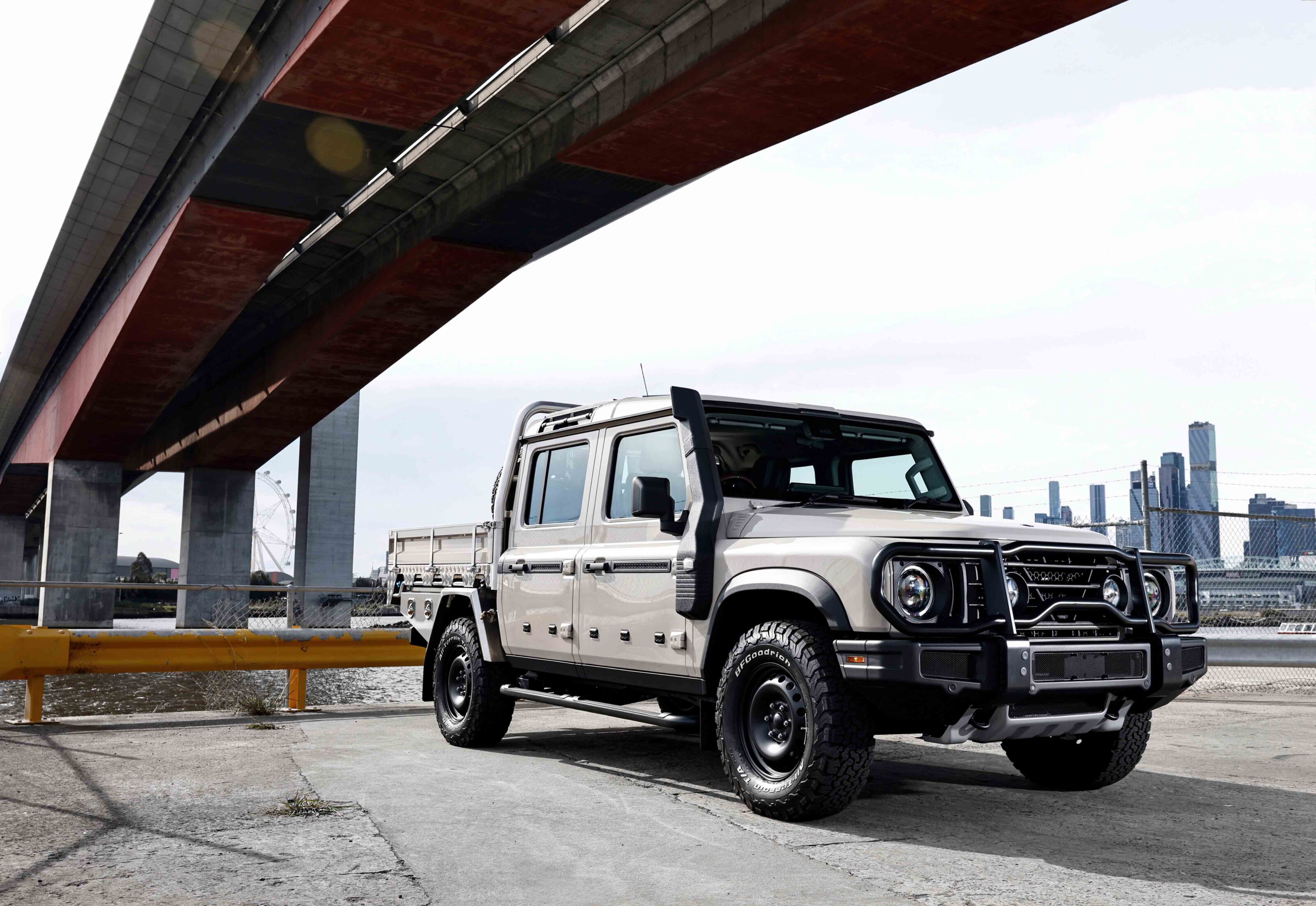
If the offer is activated, Ineos will repurchase the vehicle from customers within a six-month period, subject to vehicle condition and usage terms and conditions. More info HERE.
“As a scale-up brand we recognise that we’re combatting brand awareness and trust, to an almost David versus Goliath extent with engrained industry giants who have become a default choice, particularly in regional Australia,” said Justin Hocevar, Head of Region at INEOS Automotive Asia Pacific.
“Our ‘Love It or Leave It’ offer embodies not only our unwavering confidence in Quartermaster and the Grenadier vision, but it also demonstrates our steadfast commitment to building trust in our customers.
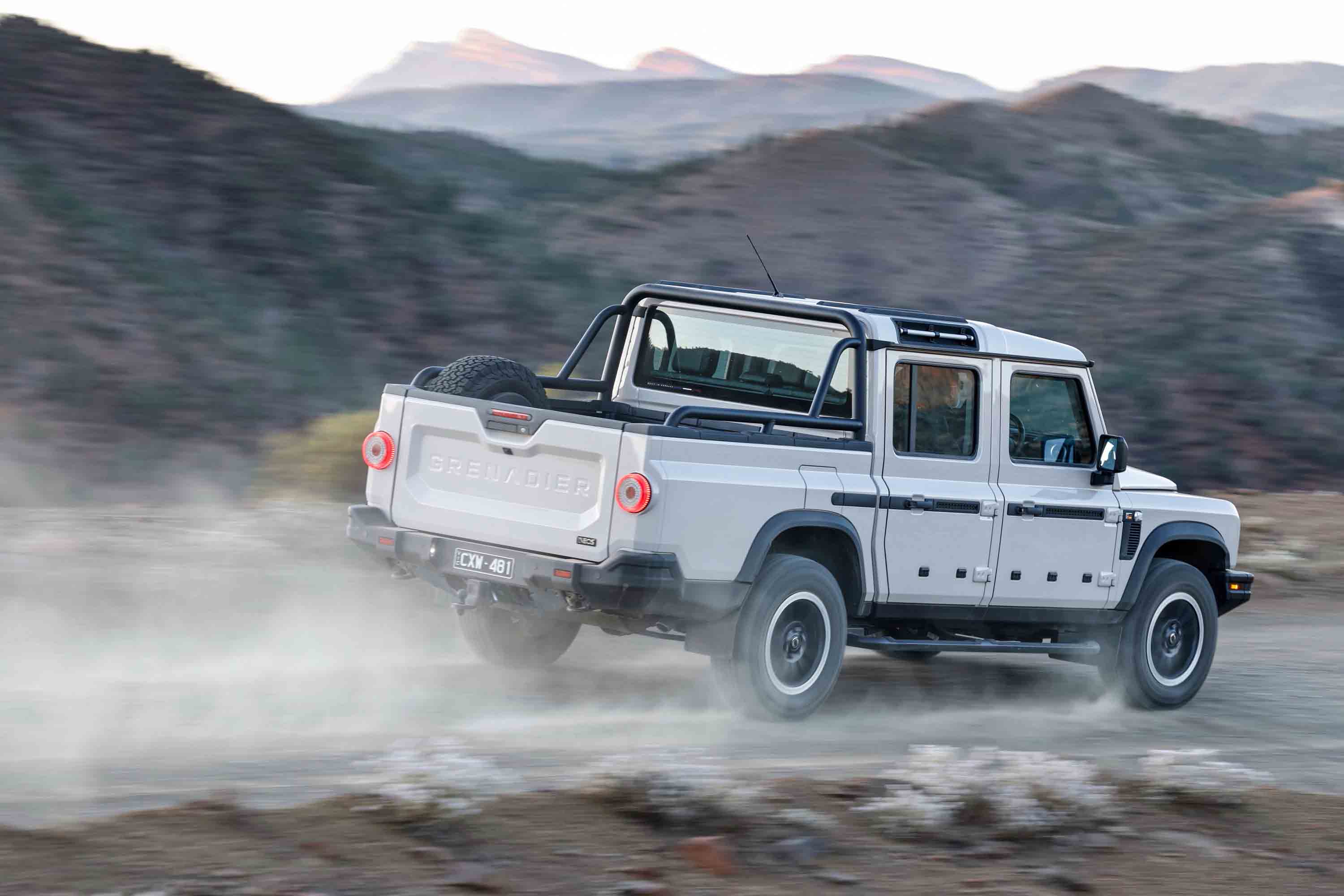
“By their nature, 4×4 enthusiasts like to challenge the status quo, yet for too long they’ve clicked their heels without the opportunity to own a vehicle that is built exactly for their specialised 4X4 interests. The Quartermaster is that vehicle.
“So, before opting for the default, we’re daring Aussies to do their research and put the Quartermaster to the test – trust us by buying it, taking it, off-road adventuring with it, and loving it… and if they don’t, leave it.”
Like the Grenadier wagon, the Quartermaster is powered by the choice of BMW 3.0-litre turbo-charged inline six-cylinder petrol and diesel engines, both paired with an eight-speed ZF automatic transmission. The ute offers 264mm of ground clearance, 800mm of wading depth, payload capacities of 907kg (petrol) and 832kg (diesel), and optional front and rear diff locks. It also rides on the same heavy-duty five-link front and rear suspension as the Grenadier wagon.
The Quartermaster cab-chassis is priced from $102,000 (plus on-road costs).
Ineos Automotive Australia has launched the ute version of its Grenadier 4×4, which it dubs the Quartermaster.
Essentially the same vehicle as the Grenadier station wagon, the Quartermaster has a 305mm longer wheelbase and is available with either a ute cargo tub or a bare cab-chassis at the back.
Of course, Ineos does offer a practical optional tray that can be fitted on the back of the cab-chassis and for this it has partnered with Australian company Norweld. Alternatively, buyers can opt to fit their own tray from any of the many suppliers available in Australia, as well as partial or full canopies that sit on a tray or directly on the chassis.
Like the Grenadier wagon to which it is pretty much identical forward of the B-pillars, the Quartermaster is offered in three specification levels with a long list of options and customisations available. Both the ute and cab-chassis are available in standard specification as well as the Belstaff editions: the Trialmaster and Fieldmaster models.
With so many options all available on any variant, owners can customise the Grenadier to their own specification. Ineos Australia told us that surveying the specification of more that 100 Grenadiers sold in Australia, they couldn’t find two that were exactly the same.
JUMP AHEAD
What do you get?
Like any ute, the Quartermaster is all about practicality and the new vehicle’s longer wheelbase (3227mm) over the wagon better locates the cargo weight over the rear axle for more stable and capable load lugging. Like the Grenadier wagon, the Quartermaster ute has a 3500kg towing capacity.
The Quartermaster has a 3550kg GVM and 7000kg GCM which should make it appealing to anyone who tows. Payload for the ute is rated at 907kg with the petrol engine and 832kg with the diesel powertrain. Payloads for the cab-chassis models aren’t quoted as this will depend on what the user places on the back of it.
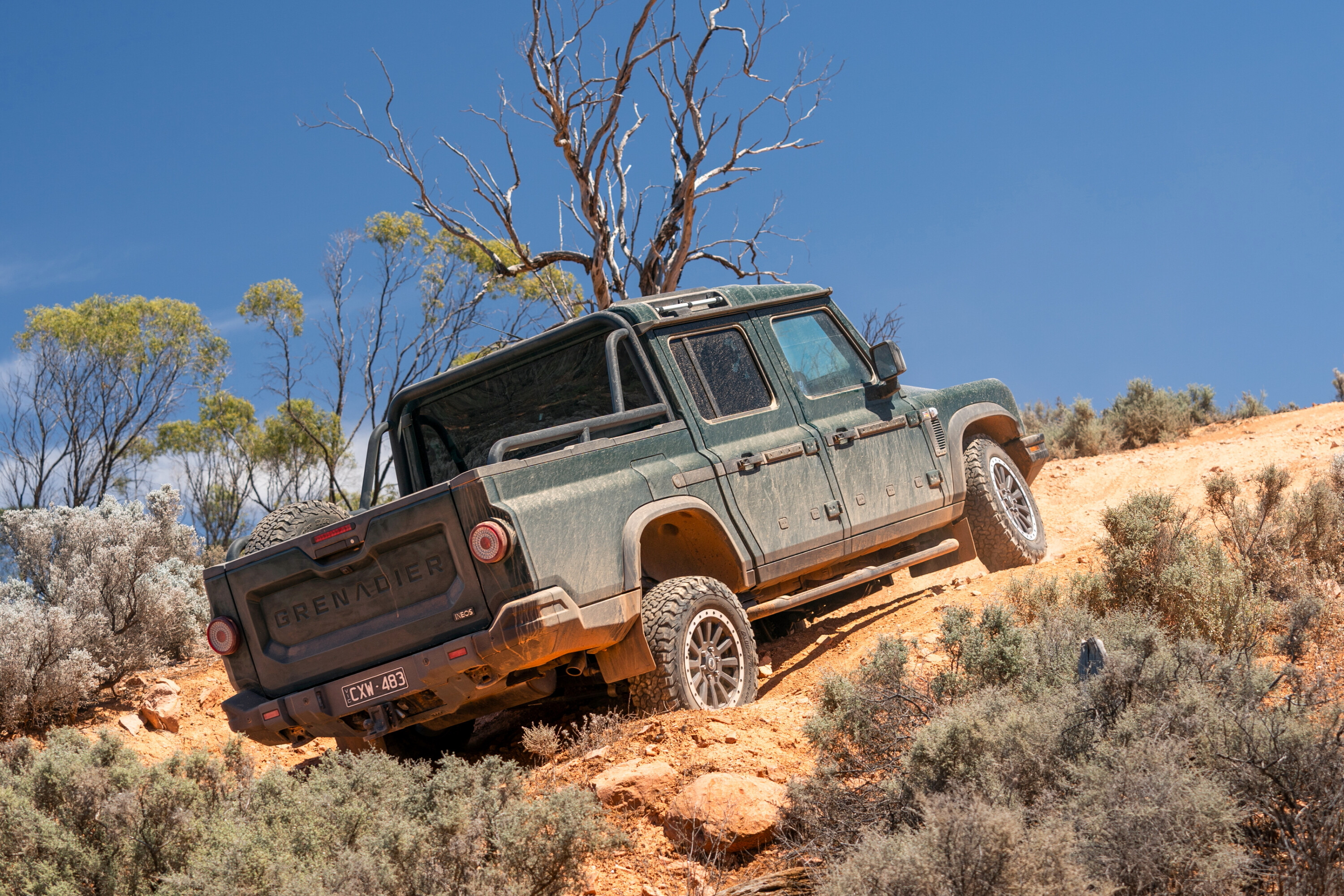
The cargo tub for the ute measures 480mm high, 1564mm long and 1619mm wide, with 1337mm between the wheel arches. The load space is somewhat compromised by the placement of the spare wheel and tyre in the tub but Ineos says that this is preferable to locating the spare under the tub, as this would have decreased departure angle. The tyre protrudes above the height of the tub and that’s something you would need to consider if you want to fit any sort of tonneau cover on it. The Quartermaster ute is 5400mm long in total.
Ineos has a range of covers available including a neat full-height canvas canopy that adds to the traditional look of the Quartermaster. These are part of an extensive list of factory-backed accessories from leading aftermarket supplies such as the Red Winches, Rhino-Rack and Redarc Electronics.
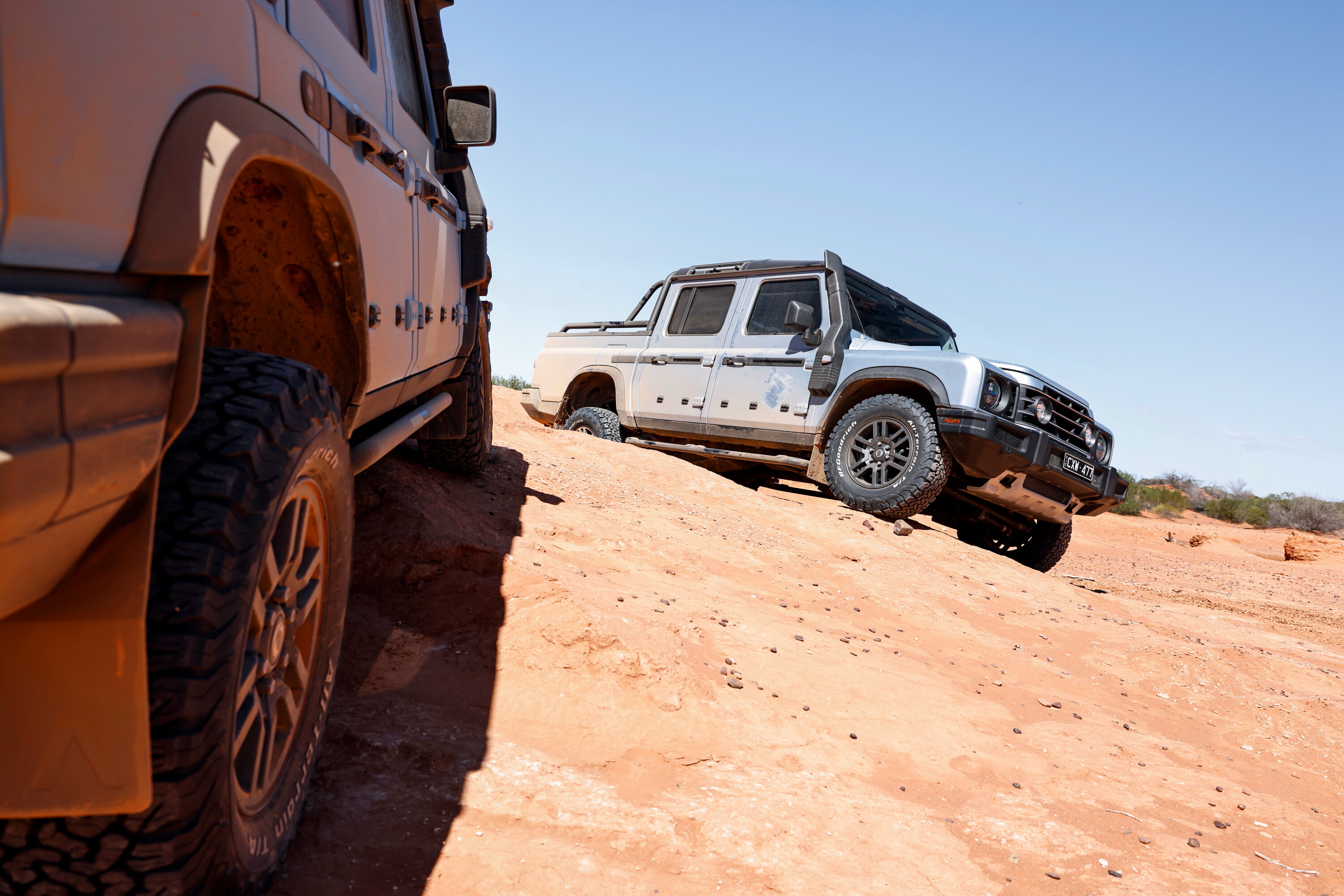
As mentioned, the Quartermaster is available with a choice of petrol and diesel powertrains as per the Grenadier wagon. Both of the BMW-sourced engines are inline sixes of 3.0-litres capacity. The B57 diesel uses sequential turbocharging to generate a claimed 183kW of power and 550Nm of torque, while the B58 petrol engine uses a single twin-scroll turbocharger to generate its claimed peaks of 210kW and 450Nm.
Again, as per the wagons, the engines are backed by a ZF 8-speed automatic transmission and a full time dual-range transfer case. Locking front and rear diffs are available depending on what specification and options are selected.
Interior
In the cabin, the only difference between the wagon and the ute/cab-chassis is in the rear seat area. The back of the seat is bolt upright in the Quartermaster and I don’t think I’d want to be sitting there for anything longer than a short trip.
Up front the dashboard and overhead controls offer a plethora of switches and dials for everything from HVAC to lockers, with additional prewired switches for auxiliary accessories such as winches, lights, inverters, fridges and other touring essentials. I’m all about having tactile switches and dials rather than controls embedded within menus in the multimedia screen, but the Grenadier takes this design philosophy to a new level, and even after a few stints in the vehicle now, they still take some familiarisation before they become second nature.
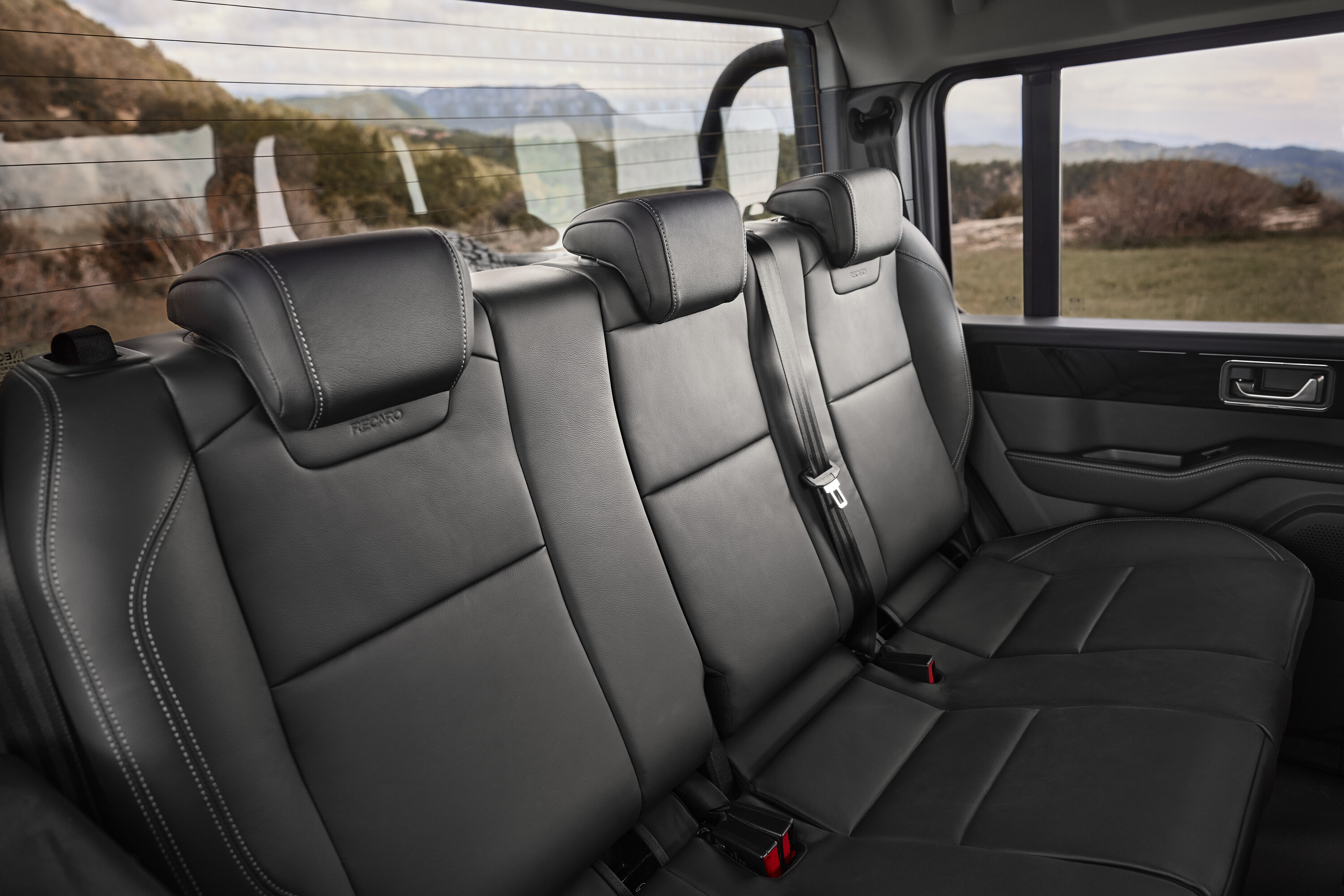
In fact, the Grenadier takes some getting used to; when I reviewed the Grenadier Fieldmaster a few months back it took a full three days of driving it before I started to feel comfortable and familiar with the cabin and controls. This time it only took half a day on the road but the feeling was better. While the controls are tactile they are not perfect; the centre diff lock, for example, is engaged using the transfer lever in the console, while the front and rear lockers are controlled by overhead switches.
Speaking of screens, the lack of a traditional gauge cluster ahead of the steering wheel in the driver’s field of vision also takes some getting used to. Instead, the digital speedometer is in the multimedia screen on the centre of the dash.
Safety
Like the Grenadier wagon, the Quartermaster ute comes with ABS, ETC, ESP, front, side and curtain airbags, lane departure warning, TPMS and trailer stability control, but it misses out on some systems that many take for granted in modern vehicles like AEB, lane keeping assist and cross traffic warnings.
While many old-school off-roaders will welcome their absence, not having these safety items might take the Ineos off the shopping list of some buyers, particularly those with families. These systems are available on the Ineos in other markets around the world but so far not here in Australia. The Grenadier has not been tested by ANCAP.
Off-road performance
While a longer wheelbase might be expected to provide improved ride quality due to better weight distribution, we didn’t find this to be the case on the Quartermaster launch drive, which was in unladen vehicles on the sometimes-rough tracks of South Australia’s Flinders Ranges.
The ride remains as firm as it is in the wagon but it feels a bit more unsettled over rough, choppy roads. As I said, these vehicles were unladen, and we’d expect a bit more compliance with some weight in the tray.
The vehicles on the launch were all wearing optional BFGoodrich All-Terrain KO2 tyres which, being a light truck tyre, have a stiff and strong sidewall which wouldn’t help ride quality either, but they do give the driver the confidence to cover rough terrain without fear of tyre damage.
| Off-road specs | Diesel | Petrol |
|---|---|---|
| Approach angle | 36.2u00b0 | 36.2u00b0 |
| Rampover angle | 26.2u00b0 | 26.2u00b0 |
| Departure angle | 12.6u00b0 | 12.6u00b0 |
| Ground clearance | 264mm | 264mm |
| Wading depth | 800mm | 800mm |
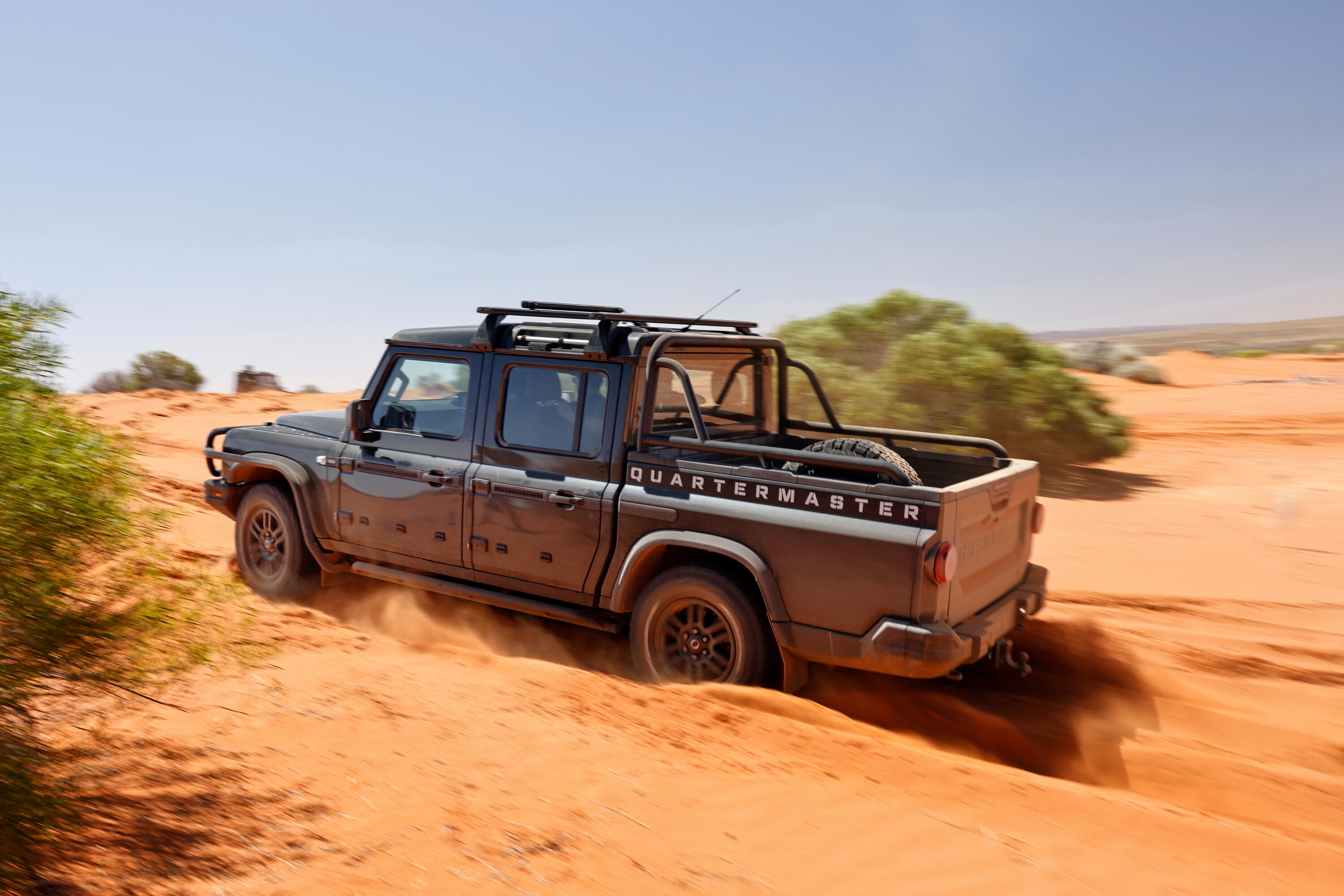
Powertrain
No complaints from the powertrain as both of the petrol and diesel engines deliver the performance you’d expect from the quoted outputs, and the Quartermaster gets along swiftly for such a heavy vehicle. That might change with a heavy load on board but to find out we’ll have to wait for a full test.
The petrol-fuelled Quartermaster scores a slightly heavier payload as a result of its lighter engine but Ineos has found that Australia favours diesel power, as only around 20 per cent of Grenadiers sold here so far have been petrol powered. The petrol engine is smooth and revs hard and higher than the diesel, as you would expect, but we didn’t expect it to be noisier; this might be a result of the different exhaust system rather than the engine itself. The petrol exhaust emits a noticeable drone at touring speeds which we think could be annoying on long trips.
There was no such drone from the diesel Quartermaster which gives gobs of torque though its rev band and we think will continue to be the engine of choice for Aussie buyers.
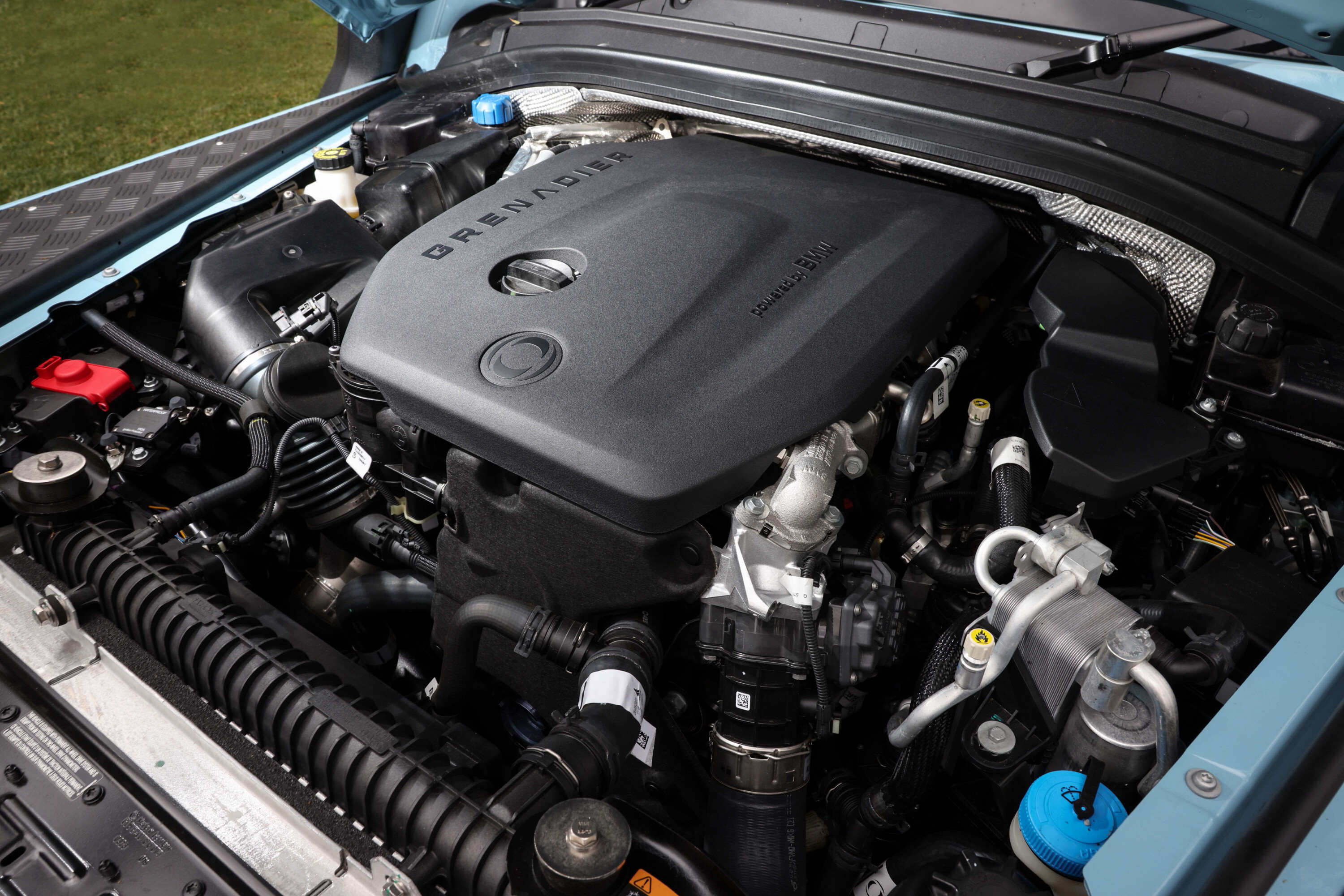
Verdict
Ineos says it has sold 1500 Grenadiers to Aussie buyers in the brand’s first year in Australia.
The introduction of the ute and cab-chassis models is expected to accelerate sales with the long wheelbase variants likely to outsell the wagon over the coming year. Aussies love a dual-cab ute and the Quartermaster adds a new option to this segment of the market, and one that will suit those looking for a capable vehicle with live axles both front and rear.
The Toyota LandCruiser 79 Series owns this live-axle segment at the moment, with the Jeep Gladiator the only other player but being more of a lifestyle off-roader than a true workhorse. The Ineos Quartermaster sits in between these two vehicles, delivering more refinement, features and comfort than the LandCruiser with more practicality and ability than the Gladiator.
It’s a very small part of the total 4×4 ute market but we’re glad Ineos has chosen to enter it with the Grenadier Quartermaster.
Specifications
| Specs | Diesel | Petrol |
|---|---|---|
| Engine | I6 bi-turbo diesel | I6 turbo petrol |
| Capacity | 2993cc | 2998cc |
| Max power | 183kW@3250-4200rpm | 210kW@4750rpm |
| Max torque | 550Nm@1250-3000rpm | 450Nm@1500-4000rpm |
| Transmission | 8 speed automatic | 8 speed automatic |
| 4×4 system | Full-time/dual range | Full-time/dual range |
| Crawl ratio | 56.37:1 | 53.81:1 |
| Construction | 4-door cabin on ladder chassis | 4-door cabin on ladder chassis |
| Front suspension | 5-link live axle on coil springs | 5-link live axle on coil springs |
| Rear suspension | 5-link live axle on coil springs | 5-link live axle on coil springs |
| Tyres | (Opt) 265/70R17 AT | (Opt) 255/70R18 AT |
| Weight | 2718kg | 2643kg |
| GVM | 3550kg | 3550kg |
| GCM | 7000kg | 7000kg |
| Towing capacity | 3500kg | 3500kg |
| Payload | 832kg | 907kg |
| Seats | 5 | 5 |
| Fuel tank | 90L | 90L |
| ADR fuel consumption | 10.5L/100km | 12.6L/100km |